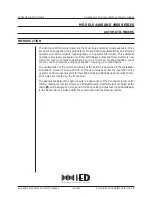
18
WZ20S
User Guide
Mono Input Channel
PAD
Affects both the XLR (if no TRS jack is plugged in) and the TRS jack
input to attenuate the input signal by 30dB. Press PAD when plugging in line
level sources, or when the signal is too high with the GAIN control turned down.
GAIN
Adjusts the input sensitivity to match the connected source to the
console 0dB operating level. This provides a wide 70dB range with continuous
adjustment for signals from –
60dBu to –
20dBu with PAD switched off, and –
30dBu
to +10dBu with PAD on. Use the PFL system to correctly set the gain using the
console meters.
100HZ FILTER
Switches in the high pass filter to cut frequencies below 100Hz
with a slope of 12dB/octave. Use this to clean up vocals by reducing
microphone proximity popping and low frequency ambient pickup, and to filter
out hum and rumble. The filter is post-insert and pre-EQ so that it affects the
signal returned from any inserted equipment by removing the unwanted low
frequencies before equalisation.
EQUALISER
The channel equaliser is a powerful tool to creatively tailor the
sound within the mix, or to deal with source problems such as poor microphone
characteristics, noise and feedback. Start with the EQ controls set to their mid
(flat) position and make sure you have chosen the best type and position of
microphone for the source. Then adjust the EQ to achieve the sound you want.
Take time to experiment with the controls so you get to learn the effect the
equaliser can have on the sound.
The WZ20S mono channel provides separate tone control over four frequency
bands including two swept frequency (parametric) mids. The frequencies in
each band may be boosted or cut by up to 15dB. The centre flat position is
detented for quick resetting.
HF
Turn this control clockwise to boost and anticlockwise to cut the high
(treble) frequencies. This has a shelving response with all frequencies above
the 12kHz turning point affected. Note that frequencies below 12kHz are
affected by a decreasing amount. Use HF boost to brighten up the sound by
adding sparkle, and cut to reduce source hiss or ambient high frequency mic
pickup.
MF1
Turn the +/- control clockwise to boost and anticlockwise to cut the higher
mid frequencies. This has a bell shaped peak/dip response that has maximum
boost or cut at the selected frequency. Use the upper control to select this
centre frequency between 500Hz and 15kHz. Boosting around 3kHz can
enhance the intelligibility of vocals helping them to cut through the mix. Cutting
to notch out a ringing frequency can help to increase the gain before feedback.
MF2
This is similar to MF1 but affects the lower mid frequencies selectable
from 35Hz to 1kHz. Boosting can enhance the warmth of the sound while
cutting can reduce the effect of resonant or boomy frequencies.
LF
Turn this control clockwise to boost and anticlockwise to cut the low (bass)
frequencies. This has a shelving response with all frequencies below the 60Hz
turning point affected. Note that frequencies above 60Hz are affected but by a
decreasing amount. Use LF boost to enhance low end punch, and cut to further
reduce source hum and rumble.
EQ IN
Switches the equaliser in or out of the signal path. Use this to check the
effect of the control settings by comparing the equalised and unequalised
signals
.
-15
-15
LF
60Hz
MF2
35Hz
-15
60
45
MF1
500Hz
700
1k
-15
12kHz
HF
GAIN
- 10
PAD
20
+ 15
+ 15
IN
EQ
0
1kHz
0
450
+ 15
300
180Hz
15kHz
0
+ 15
5k
7k
3kHz
100Hz
0
30
60
50
30
-30dB
40
PAD















































